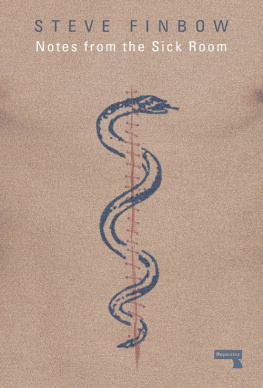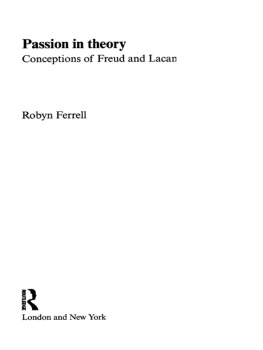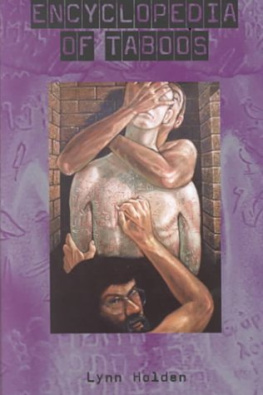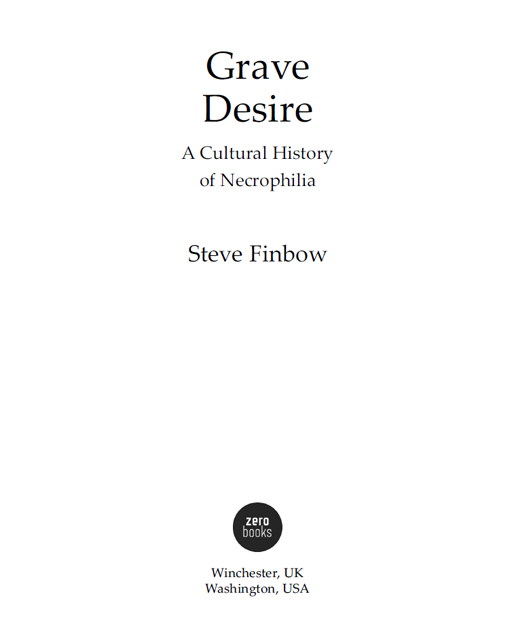First published by Zero Books, 2014
Zero Books is an imprint of John Hunt Publishing Ltd., Laurel House, Station Approach,
Alresford, Hants, SO24 9JH, UK
www.johnhuntpublishing.com
www.zero-books.net
For distributor details and how to order please visit the Ordering section on our website.
Text copyright: Steve Finbow 2014
ISBN: 978 1 78279 342 7
All rights reserved. Except for brief quotations in critical articles or reviews, no part of this book may be reproduced in any manner without prior written permission from the publishers.
The rights of Steve Finbow as author have been asserted in accordance with the Copyright, Designs and Patents Act 1988.
A CIP catalogue record for this book is available from the British Library.
Design: Stuart Davies
Printed and bound by CPI Group (UK) Ltd, Croydon, CR0 4YY
We operate a distinctive and ethical publishing philosophy in all areas of our business, from our global network of authors to production and worldwide distribution.
1
Necroduction
Cesare Lombrosothe godfather of criminal anthropologycites the case of a 40-one-year-old male named Gruyo who lived in Vittoria, Spain. Outwardly, a normal man, married three times, having no previous trouble with the law, Gruyo, over a ten-year period, strangled six women, the majority of them prostitutes. He raped some but mutilated all, severing their intestines and kidneys, pulling the organs out through the vagina.
Born in 1872, Victor Ardisson came from a long line of psychotic criminals. A feeble-minded boy, Ardisson became addicted to masturbation and the consumption of his own semen: It would be a pity to lose it, he said. Local girls spurned his sexual advances. He had a predilection for cunnilingus, liked to suck breasts, and enjoyed licking urine from toilet seats. As he matured, his fetishes grew darker, more extreme. He worked as
In Jrg Buttgereits 1987 film Nekromantik, a woman squats in the grass urinating. The car she is travelling in with her husband crashes and the films heroRobert Schmadtkearrives with his co-workers from Joes Street-Cleaning Agency to cut the man from the car, bag the womans viscera, and take the bodies back to the morgue. Robert brings body parts home with him, which he places in pickling jars on a shelf. His girlfriend Betty bathes in blood while Robert watches a television programme on phobias. He fantasizes about the killing of a rabbit, the blow to its head, the knife across its throat, its death kicks. The rabbit is skinned, its eyes excised, its intestines and organ tree removed, then its sexual organs are severed from its body. An unseen man ties the rabbit to a piece of wood, a reverse crucifixion and evisceration. Concurrently, Robert imagines himself operating on a corpse, pulling strips of intestines and other matter from it and placing the offal-like body parts in trays and bloody kidney dishes. These two imagined scenes have Roman Polanskis Repulsion (1965) and David Lynchs Eraserhead (1977) as their inspiration, a re-imagining of psychological effects and surreal imagery if not pure horror and humour. A man collects apples in an orchard, another man shoots him and then wheels the body away, hiding it in undergrowth. A few months pass, and the cleaning agency are called. Robert steals the body and takes it home where he and his girlfriend Betty caress the putrid corpse, its skin grey and liquefying, its organs protrusive and decaying, its eyes a gelid mess. Betty seems the more excited of the necrophiles, Robertto begin withcontent to watch her, the necrophiliac arousal intensified by scopophilia. The young couple saw off a chair leg, insert it into the decayed genital area of the corpse, roll a condom onto the phallic thrust of wood. Betty undresses and impales herself on the simulated penis. Robert caresses her as she rides and kisses the dead man. As the thanatic threesome move towards climax, in a Bataillean moment, Robert sucks the corpses eye into his mouth and rolls it around with his tongue, Betty also tastes the eye as it falls from its socket. After Robert loses his job and therefore is no longer able to supply corpses, Betty leaves with the dead body. Angry, Robert sets fire to a photograph of her and kills their cat. Robert pretends he is a corpse, submerged in cold water in the bath, the dead cats blood turning it red. Death obsesses himhe eats a part of the cats organs, watches as the moon turns into a skull; he dreams of being dead and playing catch with a head that turns into a piece of meat. In a cemetery, he has unsuccessful sex with a prostitute. He cannot become aroused until he kills her and then fucks her on a gravestone. Discovered by a gravedigger the next morning lying next to the womans corpse, Robert decapitates the man and watches him die bleeding and twitching. Robert, now in necrophiliac raptureand in filmic symmetry to the rabbit scenenails a figure of Christ to a cross; then, in an autoerotic act of necrophilia stabs himself with a large knife, fucking himself with the blade; his cock shooting out jizz as the blade goes in and out. The film of the rabbit, played in rewind, dresses the corpse in its own skin, re-inserts the viscera, bringing the creature alive. He feels inside his own wound and blood spurts from his cock. In the last scene, we see Roberts name on a tombstone and someone wearing womans slippers digging into the earth with a shovel. Nekromantik portrays many levels of necrophilia and the lengths people will go to to fulfil their desiresputrescence, body stealing, rape, voyeurism, and murder among them.
The corpseor work of arta polluted object, which, when viewed is sublimated in its observation, where necrophilia incorporates scopophilia, becomes the vision of beauty in excess. Bataille writes about Gilles de Rais: His crimes responded to the immense disorder which inflamed him, and in which he was lost. We even know, by means of the criminals confession, which the scribes of the court copied down whilst listening to him, that it was not pleasure that was essential. Certainly he sat astride the chest of the victim and in that fashion, playing with himself [se maniant], he would spill his sperm upon the dying one; but what was important to him was less sexual enjoyment than the vision of death at work. He loved to look: opening a body, cutting a throat, detaching limbs, he loved the sight of blood.
crucified body of Jesus Christ.
Object is an object of desire subject to detestation, of taste subject to distaste, of pleasure subject to pain. Its concave surfaces suggest female sexual organsit is fiercely anti-masculine, surprisingly political, an inward turning of all those up-thrusting phalluses created by Picasso and Brancusi. Very soft particlesbut also very hard and obstinate, irreducible, indomitable.
No matter which way you look at them, they look wrong. A head does not seem to fit the body to which it is attached, the legs are not where legs should be, the intagliated pudenda appears alien, distended sockets and dislocated limbs sprout from elongated or truncated torsos. The skin on some of them looks as though it is made from bone, and the bone looks like its crafted from flesh. These flaccid globes, like the obscene sculptures of Bellmer, reminded her of elements of her own body transformed into a series of imaginary sexual organs. She touched the pallid neoprene, marking the vents and folds with a broken nail. In some weird way they would coalesce, giving birth to deformed sections of her lips and armpit, the junction of thigh and perineum.











